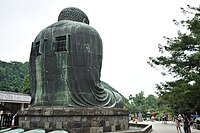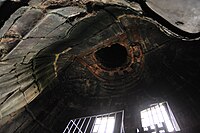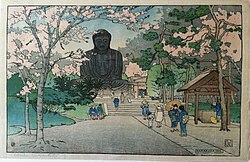Kōtoku-in
| Kōtoku-in | |
|---|---|
高徳院 | |
 | |
| Religion | |
| Affiliation | Jōdo-shū |
| Deity | Amitābha |
| Location | |
| Location | 4 Chome-2-28 Hase, Kamakura, Kanagawa Prefecture 248-0016 |
| Country | Japan |
| Architecture | |
| Completed | 1252 (Daibutsu) |
| Website | |
| kotoku-in.jp/en | |
| File:The Great Buddha at Kamakura.stl 3D model (click to interact) | |
Kōtoku-in (高徳院) is a Buddhist temple of the Jōdo-shū sect in the city of Kamakura in Kanagawa Prefecture, Japan. Its mountain name is Taiizan (大異山), and its common temple name is Shōjōsen-ji (清浄泉寺).
The temple is renowned for The Great Buddha of Kamakura (鎌倉大仏, Kamakura Daibutsu), a monumental outdoor bronze statue of Amitābha, which is one of the most famous icons of Japan. It is also a designated National Treasure, and one of the twenty-two historic sites included in Kamakura's proposal for inclusion in UNESCO's World Heritage Sites.
Kamakura Daibutsu

The Great Buddha of Kamakura (鎌倉大仏, Kamakura Daibutsu) is a large bronze statue of Amitābha, located on the temple grounds. Including the base, it measures 13.35 metres (43.8 ft) tall and weighs approximately 93 tonnes (103 tons).[1] According to temple records, the statue dates from around 1252, during the Kamakura period, which it is named after.[2]
The statue is hollow, and visitors can view the interior. Many visitors have left graffiti on the inside of the statue.[3] At one time, there were thirty-two bronze lotus petals at the base of the statue, but only four remain, and they are no longer in place.[4] A notice at the entrance to the grounds reads, "Stranger, whosoever thou art and whatsoever be thy creed, when thou enterest this sanctuary remember thou treadest upon ground hallowed by the worship of ages. This is the Temple of Buddha and the gate of the eternal, and should therefore be entered with reverence."[5]
History

The current bronze statue was preceded by a giant wooden Buddha, which was completed in 1243 after ten years of continuous labor, the funds having been raised by Lady Inada no Tsubone and the Buddhist priest Jōkō of Tōtōmi. The wooden statue was damaged by a storm in 1248, and the hall containing it was destroyed, so Jōkō suggested making a new statue of bronze, and the huge amount of money necessary for this and a new hall was raised for the project.[6] The bronze image was probably cast by Ōno Gorōemon[7] or Tanji Hisatomo,[8] both leading casters of the time.[9] At one time, the statue was gilded. There are still traces of gold leaf near the statue's ears.[10]
The hall was destroyed by a storm in 1334, was rebuilt, was damaged by yet another storm in 1369, and was rebuilt yet again.[6] The last building housing the statue was washed away in the tsunami resulting from the Nankai earthquake of 20 September 1498, during the Muromachi period.[11] Since then, the Great Buddha has stood in the open air.[11]
The 1923 Great Kantō earthquake destroyed the base the statue sits upon, but the base was repaired in 1925.[6] Repairs to the statue were carried out in 1960–61, when the neck was strengthened and measures were taken to protect it from earthquakes.[6] In early 2016, further research, restoration, and preservation work was performed on the statue.[12]
Measurements
- Weight: 121 tonnes (267,000 pounds)[13]
- Height: 13.35 metres (43.8 ft)
- Length of face: 2.35 metres (7 ft 9 in)
- Length of eye: 1.0 metre (3 ft 3 in)
- Length of mouth: 0.82 metres (2 ft 8 in)
- Length of ear: 1.90 metres (6 ft 3 in)
- Length from knee to knee: 9.10 metres (29.9 ft)
- Circumference of thumb: 0.85 metres (2 ft 9 in)
-
Close-up with a pigeon for scale
-
Rear side with open windows
-
Interior
-
Photograph from the 1880s, by Adolfo Farsari
In arts and poetry
The statue is referred to as the ″Buddha at Kamakura″ in several verses that preface the initial chapters of the novel Kim by Rudyard Kipling (1901). The verses were taken from the poem of the same name the author wrote after visiting Kamakura in 1892.[14] The poem appears in its entirety in Kipling's poetry collection The Five Nations of 1903.[14]
-
The Great Statue of Amida Buddha at Kamakura, Known as the Daibutsu, from the Priest's Garden. Watercolor painting by John La Farge, 1887
-
Kamakura. Woodblock print by Charles W. Bartlett, 1916
Gallery
-
Entrance gate
-
One of the Niō in the entrance gate
-
"Buddha's sandals" inside the temple
-
Statues outside the temple
-
Outside and inside views of the Great Buddha, 2023
See also
- List of National Treasures of Japan (sculptures)
- Tian Tan Buddha – located in Hong Kong, world's tallest seated Buddha statue
- Tōdai-ji – temple in Nara, home to largest bronze Buddha statue in Japan
- Ushiku Daibutsu – Japan's tallest statue of a Buddha in Ushiku, Ibaraki Prefecture, Japan
References
- ^ "An Overview of the Great Buddha" Kotoku-in Official Website. Accessed 20 September 2011.
- ^ R.H.P. Mason and J.G. Caiger (1997). A History of Japan (Revised ed.). Singapore: Tuttle. pp. 164–165.
- ^ Takao Sato (ed.). Daibutsu: The Great Buddha of Kamakura. Hobundo. p. 14.
- ^ Takao Sato (ed.). Daibutsu: The Great Buddha of Kamakura. Hobundo. p. 16.
- ^ Takao Sato (ed.). Daibutsu: The Great Buddha of Kamakura. Hobundo. p. 18.
- ^ a b c d Takao Sato (ed.). Daibutsu: The Great Buddha of Kamakura. Hobundo. p. 7.
- ^ Frédéric, Louis. Japan Encyclopedia Harvard University Press (2005). p. 755
- ^ Kate Tsubata (25 May 2008). "The Great Buddha at Kamakura". The Washington Times. Archived from the original on 7 June 2011. Retrieved 20 September 2011.
- ^ The New Official Guide, Japan Japan Travel Bureau (1975) p. 404
- ^ "Kotoku-in (The Great Buddha)". Kamakura Today. 2002. Archived from the original on 7 June 2012. Retrieved 9 March 2010. Accessed 20 September 2011.
- ^ a b Tsuji, Yoshinobu (1983). "Study on the Earthquake and the Tsunami of 20 September 1498". In Iida, Kumiji; Iwasaki, Toshio (eds.). Tsunamis: Their Science and Engineering, Proceedings of the International Tsunami Symposium, 1981. Tokyo: Terra Scientific Publishing (Terrapub). pp. 185–204. ISBN 90-277-1611-0.
- ^ Waku Miller (11 March 2016). "A Clean Bill of Health for Kamakura's Great Buddha". Nippon.com. Retrieved 10 November 2016.
- ^ Information about Daibutsu onsite Archived 30 June 2012 at archive.today
- ^ a b Rudyard Kipling, "The Buddha at Kamakura". Retrieved 20 September 2011.
External links
- Kotoku-in Homepage (in English)
- Kamakura Today website Archived 7 June 2012 at the Wayback Machine "Kotoku-in (The Great Buddha)" page
- Kamakura Trip website "Kamakura Daibutsu (Great Buddha of Kamakura)" page (in English)
 Geographic data related to Kōtoku-in at OpenStreetMap
Geographic data related to Kōtoku-in at OpenStreetMap











